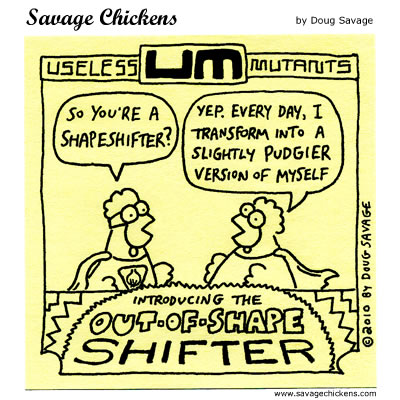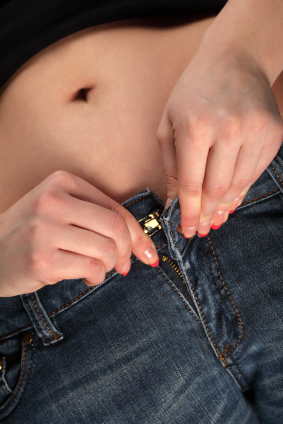Jelly in yo belly?
[The Electric Company – Retro-style illustrated lyric page for “Jelly Belly.” Art by Mell. From the Electric Company Original Cast album booklet, 1972. Courtesy: 4-Color Cowboy Vintage Print Collection]
Sigh. I’ve written about this, I’m experiencing it, heck, I’m stumped.
Belly fat.
It’s a well-known fact that many women’s fat storage begins to shift as they go through menopause. However, many women are unaware that this fat storage pattern is downright dangerous, dramatically increasing the risk for conditions like diabetes, heart disease, stroke and even some cancers.
While experts have made the connection between declining estrogen levels and an increase in fat deposits in the mid section, they have not entirely understood how it happens. That is, until now. Indeed, when researchers from Concordia University in Canada and the Mayo Clinic joined forces, they discovered that cells are the culprit. Yup, cells.
Let me explain.
Professor Sylvia Santosa, the leading investigator, says that she and her colleagues undertook the investigation because of the dangers associated with belly fat in postmenopausal women, noting that she felt that it was important to understand how low estrogen levels redirect fat storage. Consequently, she compared fat storage in 12 premenopausal and 11 postmenopausal women who were, on average, roughly 50 years old. To insure accuracy, the women all consumed the same meals for 5 days before the study and were matched by age, weight, and similar body weight, BMI and body fat compositions. They also examined the activities of fatty acids and certain enzymes that promote and alter fatty acids so that they wind up stored in the last place we’d like them to be stored: our bellies.
What they discovered is that twice as many dietary fatty acids — the type found in meals instead of the type that flow freely in the bloodstream — were being deposited into abdominal storage in postmenopausal that premenopausal women. The reason for this doubling was that the decline in estrogen appears to increase a certain protein in tissue that stores fat in the belly, and that its partner in crime – an enzyme had as much as 40% higher activity in postmenopause.
To put it in plain English: the overall fat storage machinery in postmenopausal women is faulty. Not only are we storing more fat than ever before, but our cells also don’t want to let go of it. Yikes!
While researchers continue to tease out the culprits so that they can figure out how to optimally target them, we are left with a dilemma: what now? Short of changing your diet and re-upping your exercise, or paying for fat extraction, there’s not a whole lot of ‘what.’ Unfortunately, many of us may need to live with the jelly belly the best we can.
Read MoreThe B’s have it – bursting the belly and bones myth
When it comes to aging and women, bone health is a big deal. As I’ve written time and again on Flashfree, women are at a particularly high risk for bone loss as they age because of declining estrogen levels, and in turn, a reduced ability to prevent an increase in net bone resorption (i.e. bone loss due to the activity of bone cells). And while we’ve been told that excess body fat actually protects against bone loss, novel research is putting that myth to rest. This news may affect the millions of women who are considered obese based on their body mass index (BMI > 30), who, although at greater risk for heart disease, diabetes and joint disease, were at least believed to have a weapon against osteoporosis.
In a small study that was presented at this week’s Radiological Society of North America meeting, an assessment of the abdominal and total fat and bone mineral density of 50 premenopausal women of varying BMI showed surprising results. According to the lead researcher, Dr. Miriam Bredella, “the general consensus has been that increased body fat protects against bone loss and obese women are at decreased risk for developing osteoporosis. However, we found that visceral fat — the deep belly fat — makes bone weaker.” In fact, the researchers found that women with more belly fat had significant declines in their bone mineral density and increases in the degree of fat within their bone marrow, but that total body fat or fat existing right below the skin had little impact on bones.
An important challenge for women is not only that metabolism slows and the risk for obesity increases as we age, but also, a natural increased risk for redistribution of fat to the abdominal area. And unfortunately, it’s one of the most challenging areas to address, requiring significant increases in physical activity and decreases in caloric intake. Some data suggest that isoflavones might help reduce waist circumference as well, although they are hardly definitive at this point. Still, a word to the wise: that belly fat is not going to protect your bones. Time to start moving and eating correctly; your bones will thank you.
Read MoreWednesday Bubble: Want to lose weight? Set better goals!
I can only imagine that you are rolling your eyes at the headline. But according to newly published research, how you set your weight loss goals may ultimately determine how successful or not you are at realizing them.
Let me break it down for you:
Menopause is challenging enough when it comes to weight gain and belly fat and the rest. However, are we setting ourselves up for failure when we tell ourselves that we want to lose “3 lbs?” Researchers from Florida State University and Washington University say a resounding “yes!”
They say that there is a distinction between making high-low range goals (I want to lose 2 to 4 pounds) and single number goals (I want to lose three pounds this week). This distinction makes an enormous difference, at least in terms of reengaging, i.e. doing something once and then doing it again — either by setting the same goal or setting. The high-low option actually offers an out, so to speak or as the researchers state “best of both worlds.” In other words, it’s a win-win whether or not you lose one pound or three pounds; both fall into the range that you set at the start. Conversely, a single number sets us up for ‘all or nothing’ or as I like to say, all or nothing in between. After all, isn’t is amazing when you set up to lose a pound and end up with a two pound bonus?!
To test out their hypothesis, the researchers 45 adult women around 45 years of age to establish a single number weight loss goal or high-low weight loss goal for a week over three weeks. During this time period, they attended one hour group sessions and learned about healthy lifestyle practices and weight loss was measured weekly. After three weeks, they had the option of reengaging for another 10 weeks. To avoid generalization of findings, the study was also repeated but this time, the goal had to do with overeating a regular sized bag of M&Ms and focused on achieving a target number.
So, how did the participants do?
In the weight loss study, more patients setting high-low goals reenrolled in the second portion than those setting single number goals. In the second study, the high-low goal left the participants with greater levels of accomplishment and a significantly greater interest in reengaging in goal setting again.
The key? Attainable and challenging.
Look, these numbers are small and not definitive. But it should make you stop and pause: is the way that you are setting your weight goals setting you up for success or failure? Interesting question, right?
Read MoreIt’s not weight gain! It’s a shapeshifter!
[Copyright: Doug Savage. Many thanks for use of this cartoon. Who doesn’t love a chicken?! Show some love… www.savagechickens.com]
In literature, shapeshifting takes place when an individual finds her figure involuntarily changed by someone or something else, menopause for example! For women in midlife in particular, weight gain often becomes a primary concern. But it’s not just any weight gain — it’s the spare tire in the midsection, the sudden belly that seems to appear out of nowhere, that causes the most distress.
If you go back through the archives on weight gain during menopause, you’ll discover that the midsection bulge is a personal pet peeve. And while research has shown the mindful meditation, getting up from your chair during the workday, biking and perhaps even isoflavones may make a difference, a recent review in Climacteric journal goes one step further towards clarifying the ‘why.’
The findings may interest you. For example, weight gain itself does not appear to be affected by hormonal changes during menopause. “It’s a myth that menopause causes women to gain weight” says the leading review author Professor Susan Davis from Monash University. Rather, she says that “it’s really just a consequence of environmental factors and aging,” (i.e. absolute weight gain as we age is influenced by non-hormonal factors, such as low activity levels, previous pregnancies, family history of obesity and even the use of certain antidepressants or having undergone chemotherapy). However, hormones — namely the fall in estrogen — cause the fat to deposit itself in the belly (oh, joy!). In fact, data suggest that during perimenopause, there is a rapid increase in fat mass and redistribution of this fat to the abdominal area, leading to an increase in total body fat.
Whether or not you call it weight gain or shapshifting, the result of this excess weight goes well beyond physical appearance and self esteem. We know that excess weight, especially belly fat, can lead to metabolic syndrome and other serious issues. And it’s really difficult to get rid of once it decides to rest in the abdominal area. Still, if you don’t want to go the HRT route (which may help prevent the increase in abdominal fat), there’s really only one solution: diet and exercise. And more diet and exercise.
Frustrating, isn’t it? I’d like a do-over on the shapeshifting thing. Right now? The Beast is looking pretty darn attractive!
Read More
Battle of the midlife bulge: diet+gender=
I am on a roll! On a roll around my midsection, that is.
Ever wonder why women may be likelier than men to gain fat in their abdominal area, especially as they go through menopause? Yup, we’ve talked lots on Flashfree about estrogen, exercise and even stress and the release of cortisol and how they affect that growing tummy donut. However, researchers are now adding another factor into the mix that may occur especially in women: a high-fat diet. Mind you, this particular study, which is published online in Diabetes journal, was conducted in mice so it’s way too early to comment on how the findings affect actual humans. But what it does imply is that diet might not be the only factor at play and in women, genetics and gender play an equally important role.
Researchers say that when female mice were fed a high fat diet, it triggered the production of an enzyme (called aldehyde dehydrogenase 1) that produce a hormone — retinoic acid — that boosts the formation of fat around the abdomen. Let’s step back; high fat diet leads to enzyme, leads to retinoic acid leads to belly fat. Got it?
Interestingly, not only is this enzyme activated at nine times the level in female versus male mice, but when removed, this domino effect disappears. What’s more? Estrogen can suppress the enzyme so when it starts to decline, women become more prone to developing that midsection bulge.
The culprit here is vitamin A and how the female body processes it. One of the functions of vitamin A is to produce a molecule that supports how the body burns both fat for energy and retinoic acid. Evidently, high fat diets can directly shut down the fat burning molecule and the domino effect begins, resulting in the midlife bulge many of us have come to know so well.
The good news is that on a regular diet, female mice barely produced retinoic acid, meaning the simple solution for women may be to stay away from high fat meals as much as possible.
If you can’t burn it, and you can’t rely on estrogen to keep the fire going (or take it away -ironic, right?!), then take some steps and do it yourself. D is for diet. F is for female. The endgoal? Do the math.
Read More










